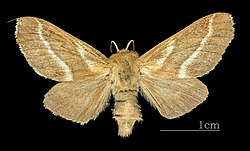| Ground lackey | |
|---|---|
 | |
 | |
| Larvae | |
| Scientific classification | |
| Kingdom: | Animalia |
| Phylum: | Arthropoda |
| Class: | Insecta |
| Order: | Lepidoptera |
| Family: | Lasiocampidae |
| Genus: | Malacosoma |
| Species: | M. castrense |
| Binomial name | |
| Malacosoma castrense | |
| Synonyms | |
| |
Malacosoma castrense (or Malacosoma castrensis in the original spelling), the ground lackey, is a moth of the family Lasiocampidae. It is a tent caterpillar found in Europe. The species was first described by Carl Linnaeus in his 1758 10th edition of Systema Naturae. The moth's habitats are salt marshes and estuaries.